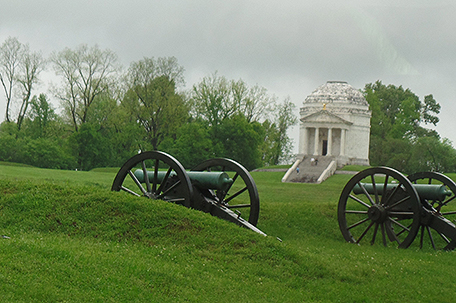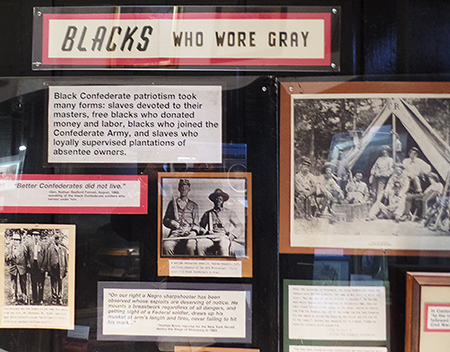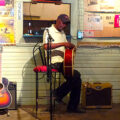
ABOVE PHOTO: Illinois Monument and Cannons
By Renée S. Gordon
The Delta Blues is a singularly American musical art form that evolved over time and because many of the early musicians were not literate they left scant information about the music they played. We do know that one of the earliest people to document hearing the daily music of the blacks was an archeologist working near Clarksdale, Mississippi. He kept notes on the instrumentation, musical patterns and themes of their songs. This was two years before W. C. Handy first heard the blues and 19 years before Mamie Smith became the first black artist to record a blues vocal. Her 1920 recording of “Crazy Blues” sold 10,000 records in seven days.
The blues may not have been born at the 10,000-acre Dockery Plantation but the plantation served to foster the musical form and functioned as a school and a showcase for the musicians. The plantation and sawmill was an insular, self-sustaining farm on the Sunflower River that was established in 1895 and employed as many as 400 tenant families. Numerous musicians either lived there or had relatives who did making this a place to visit. It was the home of Charley Patton, the most influential of the early bluesmen, and others linked to Dockery’s include Son House, Robert Johnson, Henry Sloan, Pops Staples and Howlin’ Wolf. Because of the sheer numbers of bluesmen associated with Dockery Farms it is often referred to as the “Birthplace of the Blues.” Musical events are held there and self-guided tours are offered. It was added to the NRHP in 2006. dockeryfarms.org
Cleveland, Mississippi was founded in 1885 as Sims in deference to the man who owned the land. On March 25, 1886, Sims’s son changed the town’s name to Cleveland in honor of President Grover Cleveland. The Downtown Historic District is listed on the National Register of Historic Places (NRHP) and Smithsonian Magazine designated the city “the #2 Small Town to Visit” in 2013. visitclevelandms.com
PHOTO: Blacks who wore grey.
The current Bolivar County Courthouse was constructed in 1924 on the site of a prior courthouse. Charley Patton obtained several marriage licenses there and more importantly, W. C. Handy played there. Handy is credited with being the ‘Father of the Blues” but he readily admitted that he first heard the blues in Cleveland. He and his orchestra were hired to perform in Cleveland and his music left the crowd unimpressed. A local trio took the stage and roused the crowd with their performance. Handy experienced an epiphany and went on to compose such classics as “The St. Louis Blues” and “Beale Street Blues.” A marker is outside the courthouse.
Adjacent to Cleveland’s old railroad depot sits the charming Martin and Sue King Railroad Heritage Museum. Here visitors will find the Mississippi Delta’s history told through the story of the railroad. The exhibits are housed in one huge room with a 70’ long by 17’ wide O gauge model railroad layout. This fabulous model train layout features structures of the type prevalent in the area from 1940-1960. Displays around the room showcase railroad tools, documents, artifacts and a special exhibit on how the history of the bluesmen and the railroad intersect. The museum adds substantially to the story of the Mississippi Delta.
One of my favorite sites in Cleveland is Delta State University’s A Cast of Blues Masks on view in Ewing Hall. Sharon McConnell-Dickerson, a blind sculptor, has created a series of 54 original life casts of blues artists. The casts were made directly from their faces and she has managed to capture their very essence. The masks, and a casting of Johnny Winter’s hands, will be moved later this year when the Grammy Museum Mississippi opens on the Delta State campus where they will be permanently installed. This is a unique and important site. deltacenterforcultureandlearning.com
Theodore Roosevelt once traveled Highway 61 on a bear hunt in November of 1902 and the Onward Store in Rolling Fork commemorates the event. The area’s most skilled bear hunter, Holt Collier, was called upon to make certain that the president shot a bear on his first day. Holt and his dogs ran a bear to ground but the male bear began to tear apart Holt’s dogs. In order to save his dogs Holt rendered the bear unconscious and then tethered him to a tree. When Roosevelt arrived at the scene he refused to shoot the wounded animal. The story quickly made the news and an entrepreneurial New York toy manufacturer asked Roosevelt if he could name his stuffed bears after him. From that time all stuffed bears are known as Teddy Bears.
Holt Collier was born into slavery and during the Civil War rode with Nathan Bedford Forrest as a scout and guide and was known to be an ambidextrous marksman, horseman and Texas cowboy and went on to kill over 3,000 bears, more than Crockett and Boone combined. He was arrested more than once for murder but always managed to be set free. He was born and died in Greenville. The Holt Collier National Wildlife Refuge was founded in 2004 as one of two refuges within the Theodore Roosevelt National Wildlife Refuge Complex. It is the first named in honor of an African-American.
The Onward Store opened in 1913 near the site of the bear hunt. Visitors can dine in the restaurant and then select a special souvenir in the general store. A marker is located on the grounds and this is a great place for a photo op. theonwardstore.com
While in the area you might go into Rolling Fork to read the Blues Trail Marker dedicated to McKinley Morganfield, Muddy Waters, on the courthouse square. Muddy was born here in 1915. www.msbluestrail.org
President Abraham Lincoln declared Vicksburg “the key” to control of the Mississippi and ultimately the winning of the Civil War. This statement was no surprise because from its Native American beginnings the land was intrinsically linked with the river. Vicksburg is located on a bluff on the eastern shore where the Mississippi and Yazoo Rivers meet. At the time of first European contact, the area was the territory of the Natchez and Yazoo tribes. They were driven out and the Choctaw took over.
The Spanish built Fort Nogales there in 1791 and in 1798 the Americans took possession. In 1811, the Rev. Newitt Vick founded the village of Walnut Hills. Early settlers could only enter the region by walking or riding overland or barging down the Ohio River to the Mississippi River. With the coming of the first steamboat on the Mississippi in 1812, it became easier to settle there. Walnut Hills was incorporated as the river city of Vicksburg, after Vick, in January of 1825. visitvicksburg.com
Vicksburg’s story began in the part of the Historic District on the levee and that is where it is best and most adequately told. A pictorial overview is presented by a series of 32 murals on the floodwall. The sole abstract, the first mural, was painted in 2001. riverfrontmurals.com
The Lower Mississippi River Museum helps visitors understand the history, legacy and importance of the river. The museum includes both indoor and exterior exhibitions, interactive exhibits, models and photographs. Highlights of a visit are a self-guided tour of the M/V MISSISSIPPI IV, a workboat and flagship for the Mississippi River Commission, a seven-minute orientation film and a replica of a 1927 Flood Tent. Admission is free. lmrm.org
Before heading out to Vicksburg Battlefield visitors should stop in the Old Depot Museum the popular highlight of which is a 250-sq. ft. battlefield diorama complete with 2,300 soldiers in battlefield positions. The diorama and accompanying film, “The Vanishing Glory,” provide an outstanding orientation to the siege. Other exhibits of note are 250 ship models, more than 40 original paintings and models of Vicksburg architectural styles from slave cabins to mansions. It should be noted that the museum has a decidedly southern opinion of events. diastheolddepot.net
Overlooking Vicksburg is the Old Court House Museum housing the largest collection of Civil War memorabilia in the South. The courthouse was designed by enslaved John Jackson, was built from 1858-60 by 100 slave craftsmen for $100,000 and has been a museum since 1948. During the Civil War the building was targeted until all Federal prisoners were incarcerated in the building. On July 4, 1863, the American flag was raised atop the building signaling the end of the siege. Many famous people, Grant, Roosevelt, etc., have visited the building but the largest crowd assembled on Oct. 12, 1901 to hear an address by Booker T. Washington.
This is a must-see museum with a strong focus on the human Civil War stories. There are more than 10,000 objects on display including letters, diaries, textiles, Grant’s chair and newspapers printed on wallpaper dating from the siege. Separate exhibits are devoted to slavery and “Blacks in Gray,” the little known story of African Americans who fought for the South. The gift shop is amazing and is equally as interesting as the museum. The building is on the NRHP. oldcourthouse.org
Anchuca Historic Mansion was constructed in 1830 and placed on the NRHP in 1982. The original portion was a wooden frame house with a Greek revival addition completed in 1847. It was on Anchuca’s balcony that Jefferson Davis addressed a local crowd in 1869. The mansion is now an elegant B&B and the Café Anchuca. All rooms are meticulously restored and furnished with antiques. A video tour is available online. anchuca.com
Homes and churches often served as hospitals and the Duff-Green Mansion is among them. The owners offered this 1856 mansion for use as a Confederate medical facility to save it. Confederates were placed on the ground floor and Union wounded on the roof and upper floor. It is now a Bed and Breakfast. duffgreenmansion.com
Vicksburg National Military Park is one of the two most moving battlefield sites in the nation, the other being Gettysburg, but Vicksburg is poignant in its own extremely unique way. Both battles were fought at the same time and each served as a turning point. Vicksburg, from its inception, set out to be the most accurately interpreted park. In 1899 maps were sent out to the veterans of the 28 states who fought there with requests to plot their battlefield positions. It is the only park laid out by the people who were actually there. Your visit should begin with the 20-minute orientation film followed by a 16-mile guided, by reservation, or self-guided tour.
The Confederates realized they had to defend their position on the Mississippi River and arrived in Vicksburg prior to the Union. They began fortifying their position on the high ground in September 1962 with redoubts and fieldworks constructed by slave labor. Grant’s forces arrived to take the “Gibraltar of the Confederacy” and immediately launched a series of attempts by land and water. The decision was made to lay siege to Vicksburg and a 47-day siege began on May 18, 1863. The populace took shelter, along with their slaves, in area caves. The city was surrendered on July 4th in a calculated move to obtain the best terms possible.
The 1,950-acre battlefield contains 1,340 monuments, with Union positions marked in blue and Confederate positions in red (The colors date back to the American Revolution when the enemy wore redcoats.). All the cannons in the park date from the Civil War. State memorials are designed and constructed by the individual states and maintained by the park service and Illinois has the largest number of markers because it contributed the largest number of combatants. Tiffany created the thirty-four blue-green monuments. All of the monuments are stunning and worthy of closer scrutiny but two are particularly notable.
The largest monument is a dome-shaped building erected by Illinois. All of the Illinois soldier’s names are inscribed and among them are Fred Grant and Albert Cashire. Grant was the son and aide of his father at the battle. Albert Cashire, after being hospitalized at the age of 70, was discovered to be a female.
Vicksburg was the first battle in which African American soldiers fought on the winning side and in the 1990s the City of Vicksburg appropriated $25,000 for a monument with the state adding $250,000. Dr. Kim Sessums designed the 9-ft. bronze monument, the only one dedicated to African Americans on a Civil War battlefield. Two soldiers represent the 1st and 3rd Mississippi Infantry and a civilian laborer stands for the formerly enslaved. One soldier gazes into the future, the laborer looks back on the past and the soldier they support between them represents the blood sacrificed. It was dedicated in 2004. nps.gov/vick
A partially restored Union ironclad, the USS Cairo, is on exhibition in the park. It sank in 12-minutes, with no loss of life, in the Yazoo River on December 12, 1862. The gunboat was the first victim of an electronically detonated device. Four African Americans served aboard the Cairo. An adjacent museum displays artifacts recovered when the ship was raised in 1964. nps.gov/vick/u-s-s-cairo-gunboat
We have reached the edge of the MS Delta, Vicksburg’s Catfish Row. Because the Mississippi has changed course over time the city is no longer on the Mississippi, but the Yazoo Bypass, and Catfish Row has disappeared. Like all great crossroads the legend resonates through time and continues to influence us. When you are down on the levee if you listen very hard you just might catch the faint sounds of the bluesmen, the echoes of the laborers and a whiff of a long ago perfume. Create your own crossroads adventure. visitthedelta.com
I wish you smooth travels!
Travel Tips:
The 16th Annual Blackbeard Pirate Festival, designated one of the “Top Five Pirate Festivals in North America by USA Today Travel” will be held in Hampton, Virginia from May 29-31. This is your chance to meet Blackbeard and more than 100 of his pirate friends and foe as the roam the streets of Hampton creating both merriment and mayhem as three tall ships make their appearance dockside. You can party like a pirate. The full schedule is available at www.hampton.gov/blackbeard
The Penn Museum will celebrate the sixth annual Art Museum Day on May 19, 2015
with Free Admission and Special Programming. www.penn.museum
















Leave a Comment